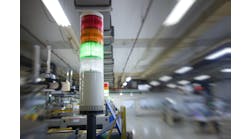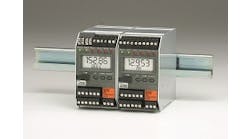Six months of planning and engineering, eight weeks of construction, 72 hours of commissioning, and your machine is finally ready for production. Despite all your best intent, you’re three minutes into the first run, and your pride and joy stops mid-cycle. What happens next has everything to do with how well you designed your controls and which features you built in to help the operator get the machine back into operation.
The first thing that you want to happen is something that draws attention to the fact that the machine or process has stopped. The prevailing method of signaling a process stop is sounding an alarm, followed by a light, or series of lights, to give some preliminary information about the source of the stop. Grouped together and commonly known as a stack light, this device should be placed prominently on your machine or process. While little has changed over the years as far as the use of a stack light, the technology has moved along nicely.
Early light stacks utilized full-voltage, incandescent bulbs inside modules of different colored plastic or glass. Variations of the method of illumination have come forth over the years, using both ac and dc voltages of a common theme to match similar control voltages. The advent of light-emitting-diode (LED) technology and more recently the LED array have brought forth a product than can be seen from great distances. One advantage of LEDs is they don’t burn out. Incandescent bulb filaments are weakened by the very thing they are intended to do, emit light. The constant heating up and cooling down that happens when voltage is applied and removed causes the filament to weaken and eventually fail. Additionally, the use of filament bulbs in a process that is subject to vibration will further reduce the life expectation of the filament. The vibration on a relatively fragile element can cause it to break prematurely. LEDs are much more resilient and stand up much better to the normal parameters under which machines function.
Horns or buzzers are used to provide an aural signal to draw the attention of the operator to a significant event. This could be to signal a fault in the machine or system but could also be used to signify the pending startup or change in operating speed. A variety of sound-making technologies have been employed over the years, culminating with products that can be directional, omni-directional and totally enclosed for use in harsh environments.
Here is an example of how one might deploy a stack light. In this situation, there is an alarm horn and a series of lights in red, yellow (or amber) green and blue. The machine/process stops and a solid horn of 3 seconds draws attention to the fact that a stop has occurred. A flashing red beacon indicates a fault has occurred. A solid red light might indicate that a safety device such as an e-stop, light curtain or door switch has been activated. The absence of a red light would indicate that a normal, operator-initiated stop has occurred. A solid yellow light indicates that the machine is in manual mode, and a flashing yellow light might indicate that the machine is in motion while in manual mode. A solid green light indicates that the machine is in motion, while a flashing green light can indicate two different functions. If the flashing green light is accompanied by an intermittent horn in the same sequence as the flashing light, then the machine is preparing to start in automatic mode. If the green light is flashing while the machine is in motion, then the machine is running, but a downstream device is preventing the machine from producing product. A flashing blue light might indicate that a consumable material, such as glue or cartons or pouches, is at a low level and, if not replaced, will cause the machine or process to come to a stop. A solid blue light could indicate that the low-level condition has elapsed and the machine has come to a stop. As can be gleaned from the description above, much can be done with what seems like a simple device to provide immediate information about the status of a machine and, if stopped, gives clues as to the source of the issue and how to respond in the most expeditious method to restore operation.
The use of LEDs in stack light technology has many benefits. An LED produces far less heat and, as such, the package used to house the light source does not have to be as big since there isn’t the need to vent the heat. This implies that the light module can be totally enclosed, meaning it can be used in environments that might be subjected to dust or water vapor. LEDs are small and, as such, can be in close proximity to other LEDs. This gives the hardware provider the option to enclose LEDs of different colors in the same small module. Since LEDs last much longer than incandescent bulbs, replacing a traditional light stack with an LED version will result in less cost and the removal of the need to maintain the light modules. Further, LED light modules are less costly to operate as they are dc-powered.
Many automation vendors have LED light stack products. The popularity of the technology has prompted creative uses of the devices. Some examples of this creativity are:
- multi-color signal modules in a single dome-shaped lens with or without sound
- traditional light stacks with alarm modules that have pre-wired pigtail connectivity
- light stacks with M12 connectivity so that the light module can be easily swapped out by simply disconnecting the cable.
Due to the low power consumption with LED technology, some manufacturers have come up with wireless light stacks. These units use Ethernet or Bluetooth technology to locate light modules on a machine or process that might normally be difficult to wire.
One vendor has taken a different track with their light stacks. The traditional light stack would have a somewhat transparent plastic lens in the color of the desired output. Newer LED versions went with a similar approach where the lens is the color of the intended output. In a further advance more recently, manufacturers are going with an array of LEDs backed by a reflector with the LED in the color of the output. The net result is a light stack that can be seen at much greater distances with far more contrast and illumination than ever before.
The convenience of small packaging for LED devices has opened up a whole new possibility for this technology. If palm-sized devices can be so easily deployed, then the inclusion of touch-sensitive devices to provide input to the process is a natural addition. The same package that provides a multi-color status light can be used for a prompt to touch device where the light turns on to signal that a response is required. The user then touches the device to provide feedback. It’s not too hard to see where this is going when a pair of these devices is tied into a control system to provide a two-handed, anti-tiedown input.
Taking the above device into yet another progression, the quick-connect M12 technology allows for a great way to make a dual redundant e-stop button with LED annunciation. One manufacturer has even taken this a bit further by lighting up an LED array around the e-stop button to draw greater attention to the triggered device. These lights, in a ring instead of a simple light on the palm button, are visible from a distance and are distinctive in that the untriggered device has a green ring around it and the tripped state is annunciated with a red ring.
In a trend that goes against the usual path of new is more expensive, LED light stacks are significantly less expensive than their incandescent predecessors. The great thing about this development is that more stack lights can be used in a design for the same cost as a single light stack of the older technology. With the example of the use of a light stack in mind, it isn’t hard to imagine the impact on the ability to get the process back in operation if more lights are viewable around the perimeter of your machine.
In my personal experience, light stacks tend to get ignored if they aren’t placed appropriately on a machine. Further, if they aren’t relied on due to poor placement, they also get ignored from a maintenance standpoint and often go without getting the lights replaced when they burn out during normal operation. With the use of LED light stacks, especially with the new, mirror-backed LED array technology, a well-placed signal device becomes an integral part of a control system. Couple that with technology that doesn’t burn out or have issues with vibration and you get a device that people tend to rely on. Our operators have embraced our standardization of the use of light stacks and often ask to have them added or replace the original equipment that came from our machine vendors. We have taken their use even further and use subtle differences in the sound pattern of the alarm horns on adjacent machines to help the operator avoid responding to signals that aren’t relevant to their production line.






